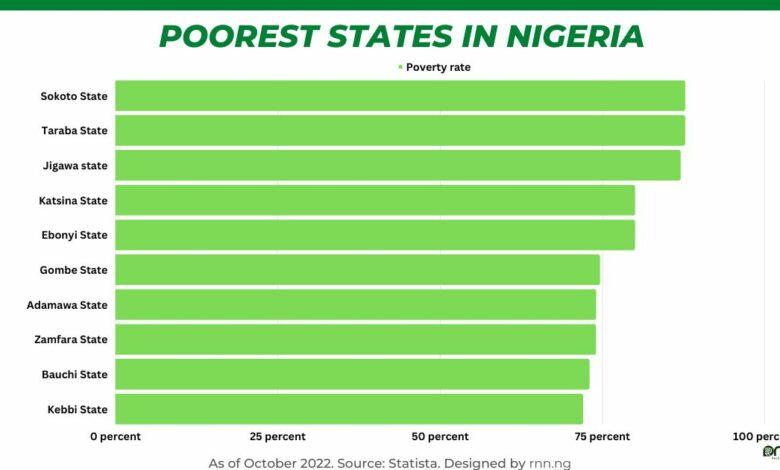
Top 15 States with High Poverty Rates in Nigeria
Top 15 States with High Poverty Rates in Nigeria – With a population of over 200 million people, Nigeria is Africa’s most populous country and one of the poorest nations in the world. Despite being the largest economy in Africa with vast oil resources, poverty remains widespread across the country. According to data from the National Bureau of Statistics, around 40% of the total population lives below the country’s poverty line of 137,430 nairas ($381) per year.Top 15 States with High Poverty Rates in Nigeria
Poverty rates vary significantly between Nigeria’s 36 states and Federal Capital Territory. Some states have poverty rates above 80%, while others are below 40%. Understanding where poverty is most severe can help policymakers better target interventions and resources to uplift the most vulnerable populations.
👉 Relocate to Canada Today!
Live, Study and Work in Canada. No Payment is Required! Hurry Now click here to Apply >> Immigrate to CanadaIn this feature article, we will highlight and profile the 15 Nigerian states with the highest poverty rates according to the latest available data. For each state, we will provide background details, examine the drivers of poverty, and overview current interventions aimed at alleviating hardship. With proactive policies and programs, Nigeria can make progress towards eradicating extreme poverty.
The Top 15 states with high poverty rates in Nigeria:
1. Sokoto State: 87.7%
Located in far Northwestern Nigeria, Sokoto State has the grim distinction of having the highest poverty rate in the country. Home to over 4.2 million residents, around 90% of the state’s population endure extreme deprivation. With high illiteracy rates, a lack of infrastructure, and an economy dependent on subsistence agriculture, Sokoto has long been left behind by Nigeria’s oil-driven growth.
Geographic isolation, ecological challenges, and religious conservatism have all contributed to Sokoto’s entrenched poverty. With low agricultural productivity resulting from frequent droughts and soil erosion, many rural communities struggle to eke out a living through farming and herding. The state also has some of the worst educational outcomes in the country, with only around 30% of children attending primary school. This lack of education locks generations into the cycle of poverty.
To address Sokoto’s deeply-rooted poverty, the state government has emphasized expanding school enrollment and improving water access for rural communities. International aid projects sponsored by UNICEF and USAID have also provided microcredit loans to boost entrepreneurship, especially for women. But much work remains to be done to broaden economic opportunities and social services in Nigeria’s poorest state.
Read Also: Top 15 Countries with high unemployment rates in Africa
2. Taraba State: 87.1%
Bordering Cameroon in Nigeria’s North East, Taraba State is the second poorest state with nearly 8 out of 10 residents living in poverty. With a population of over 2.3 million, the majority of Taraba’s people rely on subsistence agriculture to survive, cultivating crops like rice, maize, and cassava at barely sustainable levels. Land degradation and soil erosion have depleted agricultural productivity, making food insecurity a major challenge.
Years of political instability and ethnoreligious conflicts have also severely affected economic life and social cohesion in the state. Ongoing clashes between farmers and herdsmen over grazing land have resulted in high insecurity, disrupting farming and trading activities. Like other North Eastern states, Taraba’s economy has also been impacted by the Boko Haram insurgency displacing communities and disrupting farming.
In response to widespread hardship, the state administration has prioritized education and rural road construction to connect isolated villages and farms to markets. Agriculture extension programs aim to enhance crop yields for both subsistence and commercial farming. International NGOs are also active in providing livelihood skills training and microcredit for Taraba’s many unemployed youth. But deep structural reforms are still needed to spur economic diversification and lasting peace.
👉 Relocate to Canada Today!
Live, Study and Work in Canada. No Payment is Required! Hurry Now click here to Apply >> Immigrate to Canada3. Jigawa State – 86.7%
Spanning the arid countryside between Kano and Katsina, rural Jigawa State has long suffered from environmental challenges and a lack of infrastructure. Around 86.7% of residents live under the poverty line, with most engaged in subsistence agriculture and herding. With recurring droughts and floods, Jigawa has struggled to escape poverty through farming alone.
Jigawa has the lowest literacy rate nationwide, with over 70% of adults lacking basic reading and writing skills. School enrollment is also extremely low, especially for girls. This lack of education severely limits economic opportunities. The state economy is highly stagnant, with few functioning industries outside of small-scale agro-processing. Unemployment is thus widespread, along with child labor as impoverished parents put children to work early.
Under the current administration, the state government has prioritized expanding access to education. Primary school enrollment has slowly started improving, though secondary school access remains limited. Microcredit schemes targeting women have also worked to empower female entrepreneurs and artisans. Ongoing infrastructure projects like rural electrification, boreholes, and road construction also aim to open up economic activities. But Jigawa has a long path ahead to provide a decent living for its citizens.
4. Ebonyi State: 80.9%
Located in Nigeria’s South Eastern region, Ebonyi State is the 4th poorest state with around 80% of residents living in poverty. Created in 1996 as one of the country’s newer states, Ebonyi has faced the challenge of needing to rapidly build up its infrastructure and public services from scratch. The state’s estimated 2.2 million predominantly rural population relies largely on subsistence farming of crops like rice, yams, and cassava. But declining crop yields due to depleted farmland have deepened poverty over the years.
Ebonyi’s economy is also quite undiversified, with few industries to absorb the growing labor force. Illiteracy rates remain as high as 25%, reflecting the weak state of education and skills training essential for gainful employment. Poverty is distributed evenly across rural and urban areas.
To address Ebonyi’s developmental challenges, the state administration’s strategy has focused on education, agriculture, and infrastructure upgrades. Public school capacity is being expanded and new technical colleges built to enhance youth skills and employability. Ongoing road construction projects also aim to link farmers more efficiently to regional markets. But funding constraints continue to hamper poverty reduction initiatives.
Read Also: Top 15 Local NGOs in Nigeria
5. Bayelsa State: 78.8%
Holding the unenviable 5th place for poverty is Bayelsa, one of Nigeria’s major oil-producing states in the Niger Delta region. Despite massive oil wealth derived from its land, Bayelsa has struggled with extensive poverty and inequality. Around 78.8% of residents live below the poverty line, the highest rate in the South. Conflicts over resource control and oil pipeline sabotage have also plagued the state’s security and economy.
Years of oil pollution and environmental damage from spills have eroded agricultural productivity and traditional fishing livelihoods. Persistent youth unemployment fuels unrest. Equal distribution of oil revenues has been a major political challenge, with the bulk of proceeds previously going to elites.
However, Bayelsa has recently expanded social investments under a new administration, increasing funding for education, healthcare, and small business grants. A major push is underway to diversify the economy beyond oil, including initiatives to boost aquaculture, tourism, and skills acquisition. If sustained, Bayelsa can translate its oil wealth into human capital development and broad-based economic growth. But economic transparency and reduced corruption are also critical to uplift the many communities still excluded.
6. Gombe State: 74.2%
Home to about 3.25 million people, Gombe in North Eastern Nigeria features high rates of deprivation with three-quarters of the state’s population living below the poverty line. Gombe’s economy centres on small-holder agriculture like groundnut and maize farming, along with cattle rearing. But low productivity and rainfall shortages keep farmer incomes extremely low. Limited infrastructure and financial services outside of Gombe city also hamper wider economic development.
Gombe’s literacy level stands at just 50%, reflecting poor educational access and quality. School attendance is low, especially among girls due to socio-cultural norms. With low skills, youth job prospects are dim, which can fuel unemployment and unrest. Extremist violence in the region has also disrupted economic life.
In response, the state government has made technical education and agriculture modernization central pillars of its poverty reduction strategy. New agricultural extension programs aim to enhance farmer access to credit, machinery, fertilizers, and commercial markets – helping raise productivity and income. More vocational training centres are being constructed to boost youth skills. Gombe has potential but needs sustained support to uplift its people out of hardship.
7. Adamawa State: 74%
Adamawa State in North Eastern Nigeria battles high poverty with 74% of its estimated 4.25 million people living below the poverty line. One of the larger northern states, Adamawa is home to a diversity of agricultural and pastoralist ethnic groups. Subsistence farming of maize, yams, grains and cattle rearing are the economic mainstays. But climate shocks, soil erosion, and blight hurt crop yields and food security. Persistent farmer-herder conflicts over scarce grazing land have also disrupted livelihoods and stoked insecurity.
The state economy has stagnated in recent decades, with limited manufacturing and services to absorb its growing labour force. Poverty is concentrated in rural areas. The Boko Haram insurgency has further strained the economy by displacing communities, shutting down markets, and discouraging investment.
In response, the state administration has focused efforts on restoring security, constructing roads and water infrastructure, expanding school access, and providing youth vocational training programs. With peace and the right investments in human capital, Adamawa can unlock its economic potential. But greater inter-communal cooperation will also be vital for reducing poverty sustainably.
Read Also: Top 15 Best Guitarists of all Time
8. Plateau State: 74%
Centrally located between Nigeria’s north and south, Plateau State grapples with extensive poverty as 74% of citizens subsist below the poverty line. With diverse ethnic groups and a split between Muslims and Christians, Plateau has faced repeated sectarian clashes and insecurity over the decades. These conflicts have disrupted farming, trade, mining, and tourism activities.
Despite holding Nigeria’s most extensive tin mining industry, Plateau remains heavily reliant on subsistence rain-fed agriculture employing 60% of locals. Soil erosion and deterioration have contributed to low farm productivity and food insecurity. Fertilizer shortages also persist due to Plateau’s isolation from northern supply lines. Poverty reigns in rural areas.
The state government has pursued programs to expand irrigation infrastructure, provide agricultural inputs, and supply microcredit to farmers and small enterprises. Efforts to foster interfaith dialogue and resettle displaced groups also aim to restore peace and stability. But Plateau requires major private sector investment and job creation to diversify and modernize its economy.
9. Yobe State: 69.1%
Yobe State in northeastern Nigeria suffers not only high poverty but also chronic insecurity due to the Boko Haram insurgency. Around 69% of people live in poverty, predominantly in rural areas. Subsistence agriculture provides livelihoods for most households, but production is low and hardship common. Due to extremist violence, many communities have been displaced with their farms and livestock destroyed. The lack of rural infrastructure also constrains farm incomes.
Low literacy rates below 30% demonstrate poor educational access and outcomes. Yobe’s manufacturing sector is minimal, providing scarce formal job opportunities. With underinvestment in socioeconomic development and the devastation of Boko Haram attacks, poverty remains deeply entrenched.
Restoring security is paramount for Yobe’s economy to recover. The state government is also expanding access to education, healthcare, water resources, and microfinance credit to rebuild communities. With peace and improved human capital, Yobe can steadily rebuild its economy. But lasting prosperity will depend on expanding economic opportunities beyond agriculture.
10. Niger State: 76.2%
Located in North Central Nigeria along the banks of the River Niger, Niger State suffers from similarly high poverty with three-quarters of its population living below the poverty line. With 85% rural population, Niger is primarily agricultural, producing crops like rice, millet, cassava, and shea nut. But smallholder farming remains at subsistence levels, generating minimal income. Persistent flooding and erosion also hamper productivity.
Public education is still developing in Niger State with less than 50% literacy among adults. The agrarian economy offers few formal jobs, though some food processing plants have emerged. Loss of grazing land to desertification has fueled clashes between Fulani herders and farmers.
To tackle these challenges, the Niger State government has prioritized rural feeder road construction, erosion control projects, and school facilities upgrades. Agricultural initiatives aim to expand irrigation, provide fertilizer subsidies, and deliver extension services. But funding limitations continue to stunt poverty alleviation programs.
11. Kogi State: 62.5%
Bordering the Federal Capital Territory, rural Kogi State in North Central Nigeria grapples with widespread poverty at 62.5% of the population. Kogi is endowed with rich iron ore and coal deposits, but mining activity is limited. Subsistence agriculture dominates economic life, focused on crops like cassava, yams, rice, and cashew nuts. But farm productivity and income remain very low.NYSC Portal
Only around half of Kogi’s estimated 4.5 million people have basic literacy and educational attainment. Clean water access and infrastructure are also still developing. These limitations on human capital hinder economic expansion and skills development. Unemployment drives high poverty, which is concentrated among rural groups.
In response, the state administration is executing initiatives to open up more farmland, improve rural infrastructure like access roads and electricity, and expand vocational training centres and microfinance lending for farmers and small businesses. But Kogi requires greater private sector investment and value-added industries to catalyze sustainable economic growth and job creation.
Read Also: Top 15 80s Pop Songs
12. Zamfara State: 60.9%
Zamfara State in North West Nigeria suffers from endemic poverty with around 61% of its population living below the national poverty line. Widespread subsistence farming and herding supports most livelihoods in this highly rural state. But Zamfara is prone to drought and flooding, which frequently destroy local harvests and livestock. This results in chronic hunger and deprivation.
Decades of unregulated artisanal gold mining have also contaminated water sources and farmland with lead, causing major health issues. With minimal large-scale industry established, few decent wage-paying jobs exist. The majority of workers are vulnerably self-employed in the informal economy. Rampant insecurity due to cattle rustling and banditry compounds Zamfara’s economic woes.JAMB portal
In response, the state administration has focused efforts on improving food security for rural farmers, mitigating harmful mining practices, and providing better access to safe water sources. But Zamfara needs profound modernization of its agricultural sector and economic diversification beyond natural resources to tangibly alleviate poverty. This requires major public and private sector investments in infrastructure, industrialization, and skills development.
13. Nasarawa State: 60.7%
Nasarawa State in central Nigeria’s Middle Belt region faces high poverty rates, with around 61% of residents living below the poverty line. With 76% of the population engaged in agriculture, boosting low farm productivity is crucial for poverty alleviation in this predominately rural state. Most farmers rely on subsistence techniques like shifting cultivation, resulting in low crop volumes.
Land degradation and loss of grazing areas to desertification have increased resource pressures, sparking clashes between farmers and Fulani herders. Limited electricity, road, and water infrastructure also constrain Nasarawa’s economic development. Illiteracy remains above 45%, reflecting poor educational access. With low skills, few jobs exist outside menial labor and petty trading.Information guide Nigeria
To address poverty, the Nasarawa State government has prioritized expanding irrigation for farmers, improving rural road networks and electricity, and providing vocational training programs for women and youths. But relieving poverty sustainably will require major private sector investment in modernized agriculture and mineral mining. Peacebuilding initiatives are also critical for security given frequent communal conflicts.
14. Kwara State: 60.6%
Home to 3.2 million people, rural Kwara State in North Central Nigeria suffers from entrenched poverty with around 61% of residents living below the national poverty line. Despite large sugar plantations and agricultural potential, low farm productivity afflicts Kwara’s economy. Farming techniques remain basic with little mechanization. This keeps farm incomes low, spurring urban migration. Unreliable rainfall also contributes to low crop yields.
Kwara’s manufacturing base is similarly underdeveloped, with few mid-sized industries to absorb job seekers. The bloated civil service sector employs many workers, but often unproductively. These structural economic problems fuel wide unemployment and hardship. Poverty is worst in remote villages lacking infrastructure.
To alleviate rural poverty, Kwara State’s current strategy emphasizes improving farm-to-market roads, expanding irrigation facilities, and supplying fertilizer subsidies. The administration also aims to strengthen vocational training and provide small business grants. But more must be done to modernize agriculture, catalyze industrial growth, and create meaningful jobs.Romantic love message
15. Kebbi State: 59.6%
Kebbi State in northwestern Nigeria suffers from entrenched poverty with around 60% of people living below the poverty line. Situated along the Sokoto River basin, Kebbi depends heavily on agriculture and fishing. But crop yields remain low with minimal mechanization and irrigation. Most farmers rely on basic techniques, while pastoralists traverse long distances searching for grazing and water sources for cattle. This reinforces poverty.
Kebbi’s literacy rate stands below 50%, limiting economic opportunities. With few industries established, wage employment is scarce outside of subsistence farming and trading. Unemployment and underemployment are thus high, spurring socioeconomic hardship. Infrastructure deficits in power, roads and healthcare also hinder development.Good morning My Love Message
The state administration is working to expand agricultural irrigation networks, improve rural access roads, and extend microcredit and training for farmers. But driving lasting poverty reduction will require more fundamental efforts to mechanize agriculture, diversify the economy into manufacturing and services, and expand public education. Tackling ecological challenges like desertification is also critical for sustainable progress.
Read Also: Top 15 High-Demand Apple Accessories in Nigeria
Conclusion:
Nigeria’s poorest states grapple with not only deprivation today but limited socioeconomic mobility for future generations. While poverty stems from many complex factors, common challenges across these states include dependence on subsistence agriculture, deficits in infrastructure and public services like education, vulnerability to climatic shocks, and lack of economic divers.
Check JAMB RESULT
Check and Confirm: How much is Dollar to Naira





